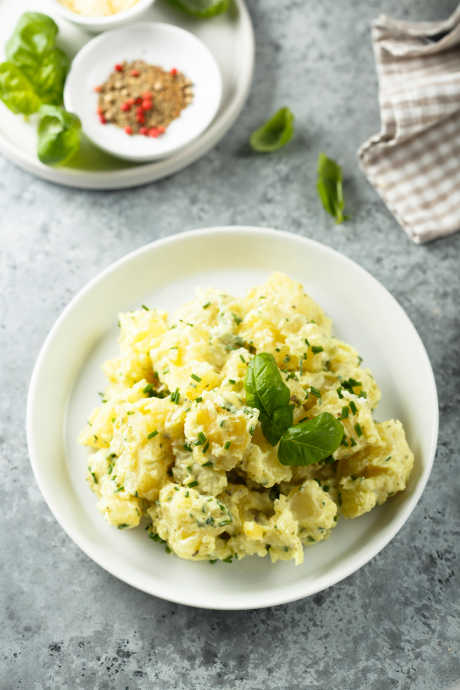4 Steps to Perfect Potato Salad
Posted by Julie on May 27th 2020
Potato salad is a quintessential summer side dish, whether you’re at a picnic or grilling out in the backyard. But people can be choosy about how they like their potato salad. We searched for some tips and tricks from trusted sources to help make your potato salad the best it can be. We’ve gathered our findings here, in four simple steps to perfect potato salad.
Step 1: Choose Your Potatoes
We’ve discussed varieties of potatoes in detail before, including the differences in texture. Texture is key when making potato salad, but it’s also a matter of personal preference. For example, The Kitchn cautions against using russet potatoes because they’re starchy and break down easily. On the other hand, Good Housekeeping likes russets for the creaminess they add to potato salad. Serious Eats notes that russets absorb seasoning more readily than other varieties.

If you prefer potatoes that hold their shape, go with The Kitchn and choose a waxy variety, like red, purple, or fingerling potatoes. Or split the difference and use Yukon Gold potatoes, which are on the starchy side and have a naturally buttery flavor. The important part is to know what sort of texture to expect from the type of potatoes you choose.
Step 2: Cook Your Potatoes
Cooking the potatoes correctly is possibly the most important step in making potato salad. All three sources -- The Kitchn, Good Housekeeping, and Serious Eats -- agree that undercooked potatoes are worse than overcooked ones, but the best potato salad requires perfectly cooked potatoes.
How do you cook potatoes perfectly? Start by cutting them into evenly-sized pieces. Then put all of the pieces into a stockpot filled with cold water before turning on the burner. The Kitchn explains that if you add potatoes to boiling water, the outside of each chunk will cook faster than the inside. As Serious Eats notes, this approach will yield potatoes that are both undercooked and overcooked, which is far from perfect.

What happens when potatoes overcook? Potato cells are full of starch, and the cells are connected with pectin. As you boil potatoes, the pectin breaks down and the starch absorbs water. Cook them too long, and they fall apart. That’s why it’s essential to watch potatoes carefully and cook them just until they are fork-tender. Drain the water from the pot, and let the heat from the pot finish cooking the potatoes.
Step 3: Season Your Potatoes
This step starts in conjunction with step 2, cooking your potatoes. Be sure to add plenty of salt to the cooking water. As we noted in step 1, some potato varieties, like russets, absorb seasoning better than others. Serious Eats also suggests adding a tablespoon or two of vinegar to the cooking water. Vinegar makes the pH of the cooking water more acidic, which prevents the pectin from breaking down as readily. In short, adding vinegar not only helps season your potatoes, it also helps you avoid overcooking them.
After your potatoes are cooked, the timing for seasoning them will depend on what sort of dressing you’re using. For a vinaigrette dressing, add the dressing when your potatoes are hot. For a mayonnaise dressing, wait until they have cooled. Bear in mind that cool potatoes will absorb less seasoning. Serious Eats explains this is due to gelatinized starch covering each piece of potato, which acts as a barrier. Plus, the potato flesh contracts as it cools.

It’s also helpful to remember that cold foods require more seasoning in general. The natural flavor of potato isn’t as prominent in a cold potato salad, so the dressing and add-ins must contain plenty of flavor.
Step 4: Prep Your Dressing and Add-Ins
This step is where you can get creative! Whether you already have a tried-and-true potato salad dressing recipe you love, or you’re looking for new ideas, you’ll start from the right place thanks to steps 1-3.
Good Housekeeping offers five dressing and mix-in combinations that look delicious. You’ll have to tweak the quantities and measurements to your personal taste, but we love the flavor profiles they’ve put together.
If you’re not yet ready to wing it, we collected a few other recommendations worth trying. First up is this recipe from A Spicy Perspective. The dressing is a classic combination of mayonnaise, yellow mustard, pickle relish, apple cider vinegar, celery seed, and paprika. The mix-ins include hard-boiled eggs, chopped sweet onions, diced celery, and fresh dill. We also agree with the recommendation to make this potato salad a day in advance of serving. Remember that flavors aren’t as sharp when foods are served cold. Allowing the flavors 24 hours to meld will give them greater depth.
We’re also curious to try this recipe from Brown Eyed Baker. Not only does it include chunks of bacon, you’ll add a couple tablespoons of bacon drippings to the dressing. The rest of the dressing ingredients include mayonnaise, Dijon mustard, sugar, and salt. The rest of the mix-in ingredients include diced celery and yellow onion, green pepper, and hard boiled eggs. No need to worry about bland potatoes with this recipe!
 Free shipping over $49
Free shipping over $49










